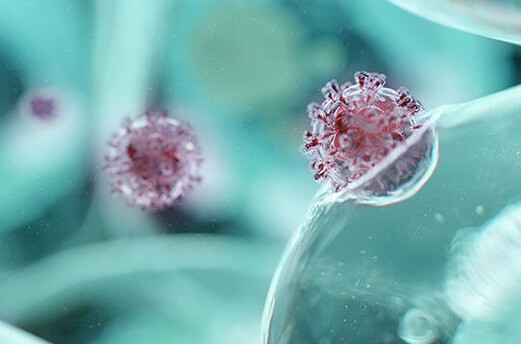
read time: 4 min
Health & Wellness, Sexual Health
Straight talk: if you’ve had sex, it’s likely that you have the human papillomavirus (HPV).
According to the Centers for Disease Control and Prevention, nearly all sexually active people will get HPV in their lifetime.1 While it’s close to impossible to avoid, the good news is that HPV doesn’t cause problems for most people. In rare cases, however, it can increase your risk of cervical cancer.
Getting an HPV infection is nothing to be ashamed about. Though understanding how HPV works is the first step in knowing how to detect it early and prevent it from leading to cancer.
What is HPV?
HPV is the most common sexually transmitted infection in the US.2 It may come as a surprise that HPV isn’t just a single virus—it’s actually a group of more than 200 related viruses.3 These viruses easily spread through sexual contact.
Signs and symptoms of HPV
Any of the HPV viruses can cause bumps or warts, called papillomas, around the genitals, mouth, or throat. While papillomas can be unsightly and itchy, they are noncancerous and disappear on their own in otherwise healthy people.
In most cases, people with HPV are asymptomatic—meaning they don’t show any signs of having the virus. HPV can actually hide in your body for years before symptoms appear. This can make it hard (and in some cases impossible) to know when you were originally infected.
The 3 possible outcomes of an HPV infection
Your immune system—your body’s natural safety net—helps keep you healthy by fighting off harmful germs, including HPV. Thanks to this powerful line of defense, an HPV infection leaves the body naturally within 2 years for as many as 90% of people with a cervix.5 In some cases, however, HPV can stay in your body for longer periods of time. Let’s explore each possible outcome:
1️⃣ Clearance
Despite having been infected with HPV, your immune system defeats the virus—ridding your body of the infection. If you took an HPV test after clearing the virus, it would come back negative.
2️⃣ Latency
The virus is latent—or hidden—in your body. You may not have any symptoms and you’d likely get a negative mRNA HPV test result. HPV can stay latent forever—you’ll never know you have it without a more specialized DNA testing.
3️⃣ Persistence
The virus lingers—or persists—in your body as an active infection. A persistent infection caused by certain types of HPV can cause precancerous cells to develop in the cervix over a time period as long as 10 years and may lead to cervical cancer. In this case, an HPV test would likely come back positive.
For most people, HPV is cleared or establishes latency, while persistence is quite rare.
Why is HPV so common?
Since people with HPV typically don’t know they have it, they can unknowingly share the virus with sexual partners. This cycle of unwittingly passing on HPV can rapidly spread the infection before anyone is the wiser.
The link between HPV and cervical cancer
Most of the 200 types of HPV viruses are considered low risk and are very unlikely to cause cervical cancer. However, there are 14 strains of HPV that are considered high-risk. These types have the potential to become a persistent infection that can lead to cancer.
Over time, a persistent high-risk HPV infection can hijack our cells and make them multiply abnormally—creating precancerous cells in the cervix. In rare instances, infections that go undetected for many years can lead to invasive cancer. While cervical cancer is the most common type of cancer linked to HPV, it can also lead to cancers of the anus, penis, throat, vagina, or vulva.
Preventing HPV from turning into cervical cancer
While cervical cancer used to be 1 of the deadliest cancers for people with a cervix, it’s now 1 of the most preventable.6 In fact, 93% of cervical cancers can be prevented through the HPV vaccination and regular screenings.7
The HPV vaccine
Since the HPV vaccine was first offered in 2006, HPV infections and cervical precancer diagnoses have decreased 88% among teen girls and 81% among young adult women.1 More than 15 years of research has shown that the vaccine is safe, effective, and long-lasting.8 Because early protection works best, the vaccine is recommended for all children 9 to 14.
Regular HPV screenings
Testing for HPV is now a routine part of gynecological exams. Anyone with a cervix who is between age 30 to 65 should be regularly screened for cervical cancer. If you are within this age range, it’s recommended that you receive a Pap test every 3 years and a high-risk HPV test every 5 years. Alternatively, your doctor may suggest co-testing—performing both tests together—every 5 years.9
Both tests require your doctor to gently scrape cells from your cervix. If you opt for co-testing, your doctor will use a single sample to screen for high-risk types of HPV and abnormal cells that might indicate precancer or cancer. Abnormal cells that are detected at the precancerous stage can be treated before they develop into HPV-related cancers.
How worried should you be about HPV and cancer?
While nearly all sexually active people will get HPV at some point in their lives, the chances of it leading to cancer are very low. Thanks to the powerful combination of increased awareness, vaccination, and pre-cancer screenings, HPV causes only 3% of cancers in women and 2% of cancers in men in the US.10 Keep in mind that there is still a risk—which is why it is important to follow your physician’s recommendations about when and how often to get screened. Regular screenings can help prevent an HPV infection from leading to cervical cancer or other serious diseases.
References
1 Reasons to Get HPV Vaccine.
Centers for Disease Control and Prevention. Reviewed November 10, 2021. Accessed December 16, 2022. https://www.cdc.gov/hpv/parents/vaccine/six-reasons.html
2 Genital HPV Infection – Basic Fact Sheet.
Centers for Disease Control and Prevention. Reviewed April 12, 2022. Accessed December 16, 2022. https://www.cdc.gov/std/hpv/stdfact-hpv.htm
3 HPV and Cancer.
National Cancer Institute. Reviewed September 12, 2022. Accessed December 16, 2022. https://www.cancer.gov/about-cancer/causes-prevention/risk/infectious-agents/hpv-and-cancer
4 HPV Infection.
Centers for Disease Control and Prevention. Reviewed July 23, 2021. Accessed December 16, 2022. https://www.cdc.gov/hpv/parents/about-hpv.html
5 HPV: 5 Things All Women Should Know.
Johns Hopkins Medicine. Accessed December 16, 2022. https://www.hopkinsmedicine.org/health/conditions-and-diseases/human-papillomavirus-hpv/hpv-5-things-all-women-should-know
6 Key Statistics for Cervical Cancer.
American Cancer Society. Reviewed January 12, 2022. Accessed December 16, 2022. https://www.cancer.org/cancer/cervical-cancer/about/key-statistics.html
7 Cervical Cancer is Preventable.
Centers for Disease Control and Prevention. Reviewed March 16, 2020. Accessed December 16, 2022. https://www.cdc.gov/vitalsigns/cervical-cancer/index.html
8 HPV Vaccine Safety and Effectiveness Data.
Centers for Disease Control and Prevention. Reviewed November 1, 2021. Accessed December 16, 2022. https://www.cdc.gov/hpv/hcp/vaccine-safety-data.html
9 Cervical cancer: screening.
U.S. Preventive Services Task Force. Published August 21, 2018. Accessed February 6, 2023. https://www.uspreventiveservicestaskforce.org/uspstf/recommendation/cervical-cancer-screening
10 HPV and Cancer.
National Cancer Institute. Reviewed September 12, 2022. Accessed December 16, 2022. https://www.cancer.gov/about-cancer/causes-prevention/risk/infectious-agents/hpv-and-cancer










